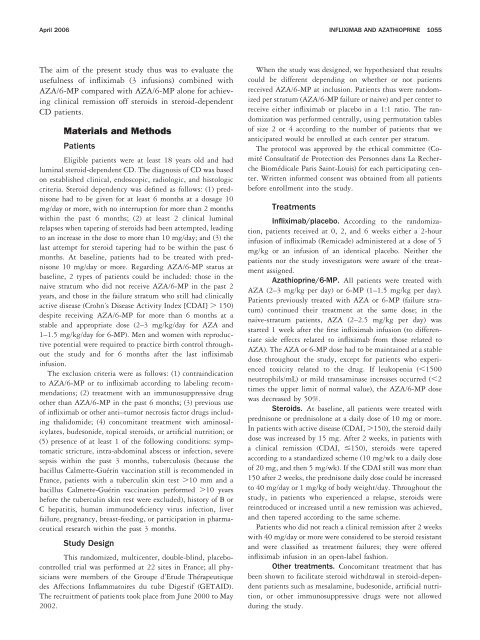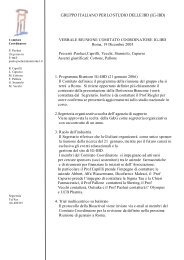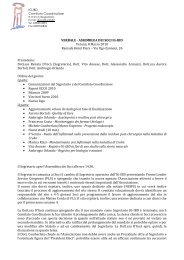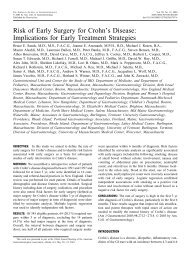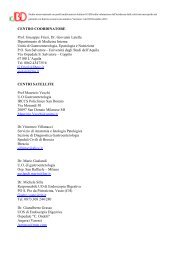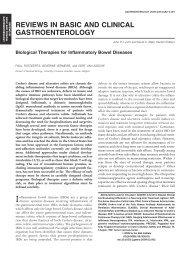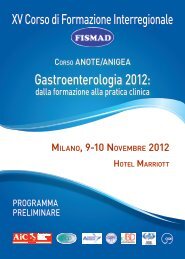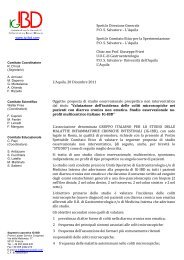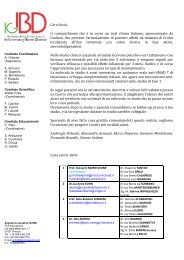marc lémann,* jean–yves mary,‡ bernard duclos,§ michel - IG-IBD
marc lémann,* jean–yves mary,‡ bernard duclos,§ michel - IG-IBD
marc lémann,* jean–yves mary,‡ bernard duclos,§ michel - IG-IBD
You also want an ePaper? Increase the reach of your titles
YUMPU automatically turns print PDFs into web optimized ePapers that Google loves.
April 2006 INFLIXIMAB AND AZATHIOPRINE 1055<br />
The aim of the present study thus was to evaluate the<br />
usefulness of infliximab (3 infusions) combined with<br />
AZA/6-MP compared with AZA/6-MP alone for achieving<br />
clinical remission off steroids in steroid-dependent<br />
CD patients.<br />
Materials and Methods<br />
Patients<br />
Eligible patients were at least 18 years old and had<br />
luminal steroid-dependent CD. The diagnosis of CD was based<br />
on established clinical, endoscopic, radiologic, and histologic<br />
criteria. Steroid dependency was defined as follows: (1) prednisone<br />
had to be given for at least 6 months at a dosage 10<br />
mg/day or more, with no interruption for more than 2 months<br />
within the past 6 months; (2) at least 2 clinical luminal<br />
relapses when tapering of steroids had been attempted, leading<br />
to an increase in the dose to more than 10 mg/day; and (3) the<br />
last attempt for steroid tapering had to be within the past 6<br />
months. At baseline, patients had to be treated with prednisone<br />
10 mg/day or more. Regarding AZA/6-MP status at<br />
baseline, 2 types of patients could be included: those in the<br />
naive stratum who did not receive AZA/6-MP in the past 2<br />
years, and those in the failure stratum who still had clinically<br />
active disease (Crohn’s Disease Activity Index [CDAI] 150)<br />
despite receiving AZA/6-MP for more than 6 months at a<br />
stable and appropriate dose (2–3 mg/kg/day for AZA and<br />
1–1.5 mg/kg/day for 6-MP). Men and women with reproductive<br />
potential were required to practice birth control throughout<br />
the study and for 6 months after the last infliximab<br />
infusion.<br />
The exclusion criteria were as follows: (1) contraindication<br />
to AZA/6-MP or to infliximab according to labeling recommendations;<br />
(2) treatment with an immunosuppressive drug<br />
other than AZA/6-MP in the past 6 months; (3) previous use<br />
of infliximab or other anti–tumor necrosis factor drugs including<br />
thalidomide; (4) concomitant treatment with aminosalicylates,<br />
budesonide, topical steroids, or artificial nutrition; or<br />
(5) presence of at least 1 of the following conditions: symptomatic<br />
stricture, intra-abdominal abscess or infection, severe<br />
sepsis within the past 3 months, tuberculosis (because the<br />
bacillus Calmette-Guérin vaccination still is recommended in<br />
France, patients with a tuberculin skin test 10 mm and a<br />
bacillus Calmette-Guérin vaccination performed 10 years<br />
before the tuberculin skin test were excluded), history of B or<br />
C hepatitis, human immunodeficiency virus infection, liver<br />
failure, pregnancy, breast-feeding, or participation in pharmaceutical<br />
research within the past 3 months.<br />
Study Design<br />
This randomized, multicenter, double-blind, placebocontrolled<br />
trial was performed at 22 sites in France; all physicians<br />
were members of the Groupe d’Etude Thérapeutique<br />
des Affections Inflammatoires du tube Digestif (GETAID).<br />
The recruitment of patients took place from June 2000 to May<br />
2002.<br />
When the study was designed, we hypothesized that results<br />
could be different depending on whether or not patients<br />
received AZA/6-MP at inclusion. Patients thus were randomized<br />
per stratum (AZA/6-MP failure or naive) and per center to<br />
receive either infliximab or placebo in a 1:1 ratio. The randomization<br />
was performed centrally, using permutation tables<br />
of size 2 or 4 according to the number of patients that we<br />
anticipated would be enrolled at each center per stratum.<br />
The protocol was approved by the ethical committee (Comité<br />
Consultatif de Protection des Personnes dans La Recherche<br />
Biomédicale Paris Saint-Louis) for each participating center.<br />
Written informed consent was obtained from all patients<br />
before enrollment into the study.<br />
Treatments<br />
Infliximab/placebo. According to the randomization,<br />
patients received at 0, 2, and 6 weeks either a 2-hour<br />
infusion of infliximab (Remicade) administered at a dose of 5<br />
mg/kg or an infusion of an identical placebo. Neither the<br />
patients nor the study investigators were aware of the treatment<br />
assigned.<br />
Azathioprine/6-MP. All patients were treated with<br />
AZA (2–3 mg/kg per day) or 6-MP (1–1.5 mg/kg per day).<br />
Patients previously treated with AZA or 6-MP (failure stratum)<br />
continued their treatment at the same dose; in the<br />
naive-stratum patients, AZA (2–2.5 mg/kg per day) was<br />
started 1 week after the first infliximab infusion (to differentiate<br />
side effects related to infliximab from those related to<br />
AZA). The AZA or 6-MP dose had to be maintained at a stable<br />
dose throughout the study, except for patients who experienced<br />
toxicity related to the drug. If leukopenia (1500<br />
neutrophils/mL) or mild transaminase increases occurred (2<br />
times the upper limit of normal value), the AZA/6-MP dose<br />
was decreased by 50%.<br />
Steroids. At baseline, all patients were treated with<br />
prednisone or prednisolone at a daily dose of 10 mg or more.<br />
In patients with active disease (CDAI, 150), the steroid daily<br />
dose was increased by 15 mg. After 2 weeks, in patients with<br />
a clinical remission (CDAI, 150), steroids were tapered<br />
according to a standardized scheme (10 mg/wk to a daily dose<br />
of 20 mg, and then 5 mg/wk). If the CDAI still was more than<br />
150 after 2 weeks, the prednisone daily dose could be increased<br />
to 40 mg/day or 1 mg/kg of body weight/day. Throughout the<br />
study, in patients who experienced a relapse, steroids were<br />
reintroduced or increased until a new remission was achieved,<br />
and then tapered according to the same scheme.<br />
Patients who did not reach a clinical remission after 2 weeks<br />
with 40 mg/day or more were considered to be steroid resistant<br />
and were classified as treatment failures; they were offered<br />
infliximab infusion in an open-label fashion.<br />
Other treatments. Concomitant treatment that has<br />
been shown to facilitate steroid withdrawal in steroid-dependent<br />
patients such as mesalamine, budesonide, artificial nutrition,<br />
or other immunosuppressive drugs were not allowed<br />
during the study.


